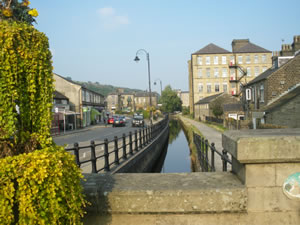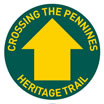Location and History
The Yorkshire Colne Valley lies in the southern Pennines, roughly 20 miles equidistant from Leeds and from Manchester. Routes between towns in Yorkshire and Lancashire pass through the Standedge gap, from Halifax, Huddersfield, Wakefield, York to Manchester, Oldham, Rochdale, Chester.
Although paths and drove roads existed in the Iron Age, in the first century AD the Romans tramped through the valley between their forts at Castleshaw and Outlane on the military road between Chester and York/Ilkley. They marked every thousandth double-step with a stone, usually cylindrical – the Latin for thousand is ‘mille’, hence ‘miles’.
After the Romans left, routes developed to meet community needs, for people to attend their church, to pay their dues to the Lords of the Manor, for trade and commerce. Travel was on foot or by horseback, donkey or mule, into the Middle Ages and  beyond.
beyond.
The tracks were in such poor condition that in 1555, wanting increased trade and therefore tax-take, Bloody Mary passed an Act of Parliament making local parishes (or townships in the north) responsible for the upkeep of the tracks in their area, so boundary markers became important.
All men had to spend five days each year working on the highways, unless they owned property and could pay a tax called The Composition, 6d in the £ on the value of their land and buildings.
Travellers passing through the West Riding such as John Ogilby and Celia Fiennes commented on the awful state of the highways in the 1600s, echoed later by Daniel Defoe. People often became lost and perished on the moors, so in 1697, the Justices of the Peace were ordered to erect guideposts (called ‘stoops’ in the Pennines) on the moors and where highways intersected. However, this was rarely enacted in the West Riding and more legislation was passed in the 1730s.
At this time, travel by road was slow and difficult. The sunken lanes became quagmires in wet weather and occasionally both horses and riders were drowned. It took 16 days to cover the 400 miles from London to Edinburgh. So Turnpike Trusts were set up, by Acts of Parliament, from 1706 to the 1840s. Groups of local worthies raised money to build stretches of road and then charged the users tolls to pay for it – just like the ‘M6 Toll’ today.
The name ‘turnpike’ comes from the spiked barrier at the Toll Gate or Bar. The poor bitterly resented having to pay to use the roads and there were anti-turnpike riots. There were two tollhouses in Slaithwaite; one still exists at Linthwaite, the (cycle) shop by the Titanic Spa traffic lights. There was also a tollhouse at Gilberts, at the end of Mount Road.
 The routes across the Pennines were unsuitable for wheeled traffic. Indeed, when pews made in Saddleworth were delivered to Marsden chapel in 1759, the wagon reached as far as Pule Gate and caused more excitement than the pews! The first trans-Pennine road ran from Rochdale to Halifax and Elland, the current A58, the Act being passed in 1735.
The routes across the Pennines were unsuitable for wheeled traffic. Indeed, when pews made in Saddleworth were delivered to Marsden chapel in 1759, the wagon reached as far as Pule Gate and caused more excitement than the pews! The first trans-Pennine road ran from Rochdale to Halifax and Elland, the current A58, the Act being passed in 1735.
See more about packhorse tracks, turnpikes and toll houses...
The people of Manchester and Oldham constructed a turnpike road to the county boundary with the West Riding, at Austerlands, also in 1735:
Some twenty four years later, the Yorkshire worthies decided it was worth joining up and the first Wakefield to Austerlands Turnpike Act was passed in 1759. The route ran south of Pule Hill, now the Old Mount Road, crossing some ‘slades’ or boggy ground. Blind Jack of Knaresborough tendered to build the road but the Turnpike Trustees wanted the boggy section deeply excavating. Jack offered to do it differently and said he would repair it at his own expense if not durable. He ordered flexible foundations and tight bundles of furze and gorse, which stood the test of time. The later turnpike bypassed this section.
 From 1767, mileposts were compulsory on all turnpikes, not only to inform travellers of direction and distances, but to help coaches keep to schedule and for charging for changes of horses at the coaching inns. The distances were also used to calculate postal charges before the uniform postal rate was introduced in 1840. There is a 1760s/70s milestone on the Chain Road, Meltham Road, at Badger Gate – ‘gate’ means ‘way’ and ‘badger’ was another name for a pedlar or jagger.
From 1767, mileposts were compulsory on all turnpikes, not only to inform travellers of direction and distances, but to help coaches keep to schedule and for charging for changes of horses at the coaching inns. The distances were also used to calculate postal charges before the uniform postal rate was introduced in 1840. There is a 1760s/70s milestone on the Chain Road, Meltham Road, at Badger Gate – ‘gate’ means ‘way’ and ‘badger’ was another name for a pedlar or jagger.
The Huddersfield Narrow Canal was begun with great optimism in 1794, to provide a link across the Pennines. Work camps were established at various strategic locations to house the numerous local labourers and craftsmen, the original navigators, later abbreviated to 'navvies'. A series of 74 locks along its 19.75 mile length raises the canal to a height of 645 feet above sea level, making it Britain's highest canal.
The Standedge Tunnel proved a formidable obstacle and Thomas Telford was appointed in 1806 to finalise the work. The tunnel was officially opened in 1811, allowing through navigation for the first time between Huddersfield and Ashton-under-Lyne. However, by 1844 canal freight rates had fallen such that it was uneconomical to continue and the canal was sold to a railway company, who utilised it to build tracks still in use today. The canal was closed in 1944 and re-opened in 2001 through the efforts of local enthusiasts.
From the 1840s, rail travel overtook road for longer journeys and many turnpike trusts were wound up. In 1888, the new County Councils were given responsibility for main roads and rural district councils for minor routes. The West Riding County Council decided to replace the earlier milestones on the main roads and let a contract for 210 cast iron ones, in the early 1890s, to be cast at the Liversedge foundry of Brayshaw & Booth, and erected by a small family firm, Gill Stead. Five of these milestones still survive along the Manchester Road between Linthwaite and Marsden. While many milestones were removed or defaced by Government decree in WWll to baffle invading Germans, these were not damaged.
 Elsewhere in the area, there are parish boundary markers on Marsden Moor, a defaced Health Board boundary stone at Slaithwaite and a Turbary stone by Old Mount Road indicating peat cutting rights.
Elsewhere in the area, there are parish boundary markers on Marsden Moor, a defaced Health Board boundary stone at Slaithwaite and a Turbary stone by Old Mount Road indicating peat cutting rights.
On our Crossing the Pennines Trail, we will see reminders of all these travellers.
What is there to see and do in the Valley besides the walks, road-trips and cycle routes?
There are plenty of quirky shops in the villages as well as pleasant cafes, ice-cream parlours, pubs and the Riverside Brewery in Marsden.
The Colne Valley Museum at Golcar shows life at the beginning of the Industrial revolution that transformed the valley from home-based textile production to mills powered by steam from the river Colne.
The Manor House at Slaithwaite and the Silent Woman pub opposite have featured in various TV soaps, including ‘Where the Heart Is’.
Glory days as a spa town are commemorated in Spa Park.
The striking Mechanics Institute at Marsden was originally an educational centre for Victorian workers, now housing the Tourist Information Centre and the Mikron Theatre company.
On Towngate, don’t miss the old Stocks and the tomb of Enoch Taylor, who manufactured both textile machinery and the hammers the Luddites used to wreck those machines. 
See more about the industrial revolution... and some publications about Marsden...
Following the Marsden Moor Standedge Heritage Trail or taking a boat trip through the Standedge Tunnel leads to Saddleworth, with Grandpa Green’s excellent ice cream parlour at Weakly, and a fascinating folk museum in Uppermill.
The Colne Valley has its own Male Voice Choir, Slaithwaite has its Philharmonic Orchestra and Marsden has its Silver Band. Champion brass bands Black Dyke and Brighouse & Rastrick give concerts in Uppermill.
There are plenty of lively events in the locality – the Marsden Jazz Festival each October, the Slaithwaite Moonrakers, Cuckoo Day, the Saddleworth Rush-Bearing procession in August, and the Bank Holiday Brass Band Contest.







